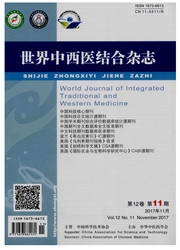

 中文摘要:
中文摘要:
目的:用去势SD大鼠造围绝经综合征肝郁模型并从其外观特征及行为学水平评价建模的效果。方法:24只雌性SD大鼠被随机等分为假手术组、去势空白组和去势模型组,每组各8只。在去卵巢制备围绝经期综合征模型的基础上,加以21 d慢性束缚应激结合孤养法建立肝郁模型。应激结束后,观察各组大鼠外观特征,检测各组大鼠体质量、1%糖水消耗率及旷场行为的改变。结果:与假手术组比较,大鼠去势后体质量显著增加,差异有统计学意义(P〈0.05);应激造模开始后,去势模型组体质量增长缓慢甚至下降,大鼠毛发干枯、活动减少、大便次数增多、便溏;与假手术组相比,去势空白组和去势模型组在旷场实验中的水平得分和垂直得分均明显降低,差异均有统计学意义(P〈0.01);去势模型组较假手术组和去势空白组的糖水偏爱率显著下降,差异均有统计学意义(P〈0.01)。结论:雌性SD大鼠去势后也会产生部分围绝经期肝郁样症状。在慢性束缚应激结合孤养法的作用下,大鼠的体质量、行为活动进一步减少,因此该方法可以有效复制围绝经期综合征肝郁大鼠模型。
 英文摘要:
英文摘要:
Objective: To establish a model of perimenopausal liver-qi stagnation syndrome by using ovariectomized SD rats, and to evaluate the animal model through it's appearance and behavioral manifestations changes. Method: A total of 24 adult female SD rats were randomly divided into 3 groups: sham group, ovariectomized Control group and ovariectomized model group,8 rats in each group.On the basis of the ovariectomized perimenopausal syndrome model, the rats were subjected to 21 days chronic restraint stress and isolation rearing. After stress, the appearance, body weight, open-field test and sucrose consumption were measured. Result: As compared with the sham group, the body weight significantly increased in the ovariectomized groups, the differences were statistically significant ( P〈0.05 ) . However, when the restraint stress begins, the body weight of ovariectomized model group increased slowly with dry and disheveled hair, reduced movements, increased watery stool. Compared with the sham group, the horizontal and vertical movement activities in the open field test significantly decreased in ovariectomized control group and ovariectomized model group, the differences were statistically significant ( P〈0.01 ) . The sucrose preference significantly decreased in ovariectomized model group as compared with sham group and ovariectomized control group, the difference was statistically significant (P〈0.01) .Conclusion: Ovariectomy causes perimenopausal liver-qi stagnation like symptoms in the female SD rats. Under the effect of chronic restraint stress and isolation rearing, the body weight and behavior changes further decreased, indicating that it' s an ideal model for perimenopansal liver-qi stagnation syndrome.
 同期刊论文项目
同期刊论文项目
 同项目期刊论文
同项目期刊论文
 期刊信息
期刊信息
